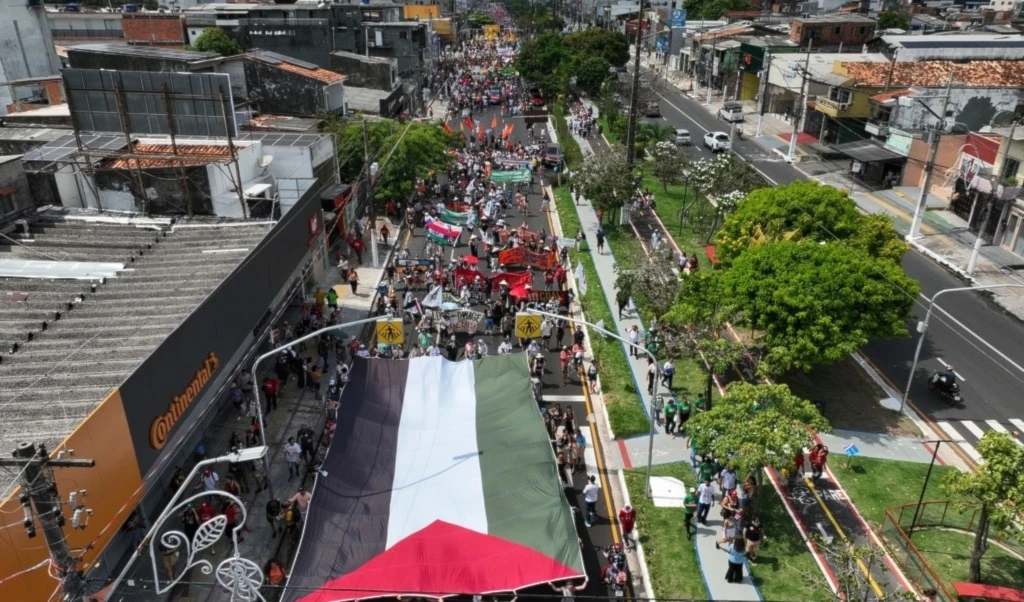Vietnam prepares for Typhoon Bualoi with evacuations amid climate risk
Typhoon Bualoi is expected to strike Vietnam's central coast with high winds and widespread flooding, prompting the evacuation of over 250,000 people.
-

People wade through a flooded alley caused by Typhoon Kajiki in Hanoi, Vietnam, Tuesday, August 26, 2025. (AP Photo/Huy Han)
Vietnam is preparing for the arrival of Typhoon Bualoi, which is expected to make landfall on Sunday evening with winds reaching 133 km per hour, according to the National Center for Hydro-Meteorological Forecasting. The storm, currently moving across the sea, is projected to strike the country’s central coast at approximately 7:00 pm local time (1200 GMT).
Described as the 10th major storm to affect Vietnam in 2025, Typhoon Bualoi is generating intense winds of up to 130 kph (80 mph) and is forecast to bring a combination of destructive weather conditions, including heavy rain, floods, landslides, and coastal inundation.
In preparation for the storm, Vietnamese authorities announced the evacuation of more than 250,000 residents from vulnerable coastal areas. The move is part of a nationwide response to the typhoon and its potential to trigger multiple forms of natural disasters.
Read more: Vietnam farmers offered cents on the dollar for Trump backed golf-club
Danang, central Vietnam's largest city, plans to evacuate over 210,000 residents, while more than 32,000 people living in low-lying areas of Hue are also set to be moved to safer ground, state media reported. In Ha Tinh Province, a key steel-producing region, approximately 15,000 residents are being relocated to schools and medical centres repurposed as temporary shelters.
Danang, Hue, and Ha Tinh brace for impact
Local officials have taken extensive precautionary measures to minimize the potential damage from Typhoon Bualoi. All fishing boats within the storm's projected path have been ordered back to port, and four domestic airports have been shut down.
“I feel a bit anxious but still hopeful that everything will be fine in the aftermath. We were all safe after the recent typhoon Kajiki. I hope this one will be the same or less severe,” Nguyen Cuong, a 29-year-old resident of Ha Tinh City told AFP.
Vietnam has mobilized nearly 117,000 military personnel to support evacuation and emergency response operations. Authorities are positioning emergency teams and equipment in high-risk zones to respond quickly to potential floods, landslides, and infrastructure damage.
Read more: Vietnam tycoon's jail term cut to 30 years in $17 bln money laundering
Mai Van Khiem, director of the national weather centre, warned that Typhoon Bualoi is a “fast-moving storm with very strong intensity and a wide area of impact, capable of causing a combination of various types of natural disasters,” according to state media.
Climate change increasing storm intensity in Vietnam
Scientists continue to warn that climate change is contributing to the increasing intensity and frequency of storms across Southeast Asia. Human-driven global warming is believed to be amplifying the destructive potential of tropical cyclones, making events like Typhoon Bualoi more common and severe.
According to Vietnam’s Agriculture Ministry, more than 100 people were either killed or reported missing in natural disasters during the first seven months of 2025. The country also suffered $3.3 billion in economic losses from Typhoon Yagi in September 2024, which caused hundreds of fatalities in the north.
Read more: Super Typhoon Ragasa hits Hong Kong and Taiwan, flooding widespread

 3 Min Read
3 Min Read










